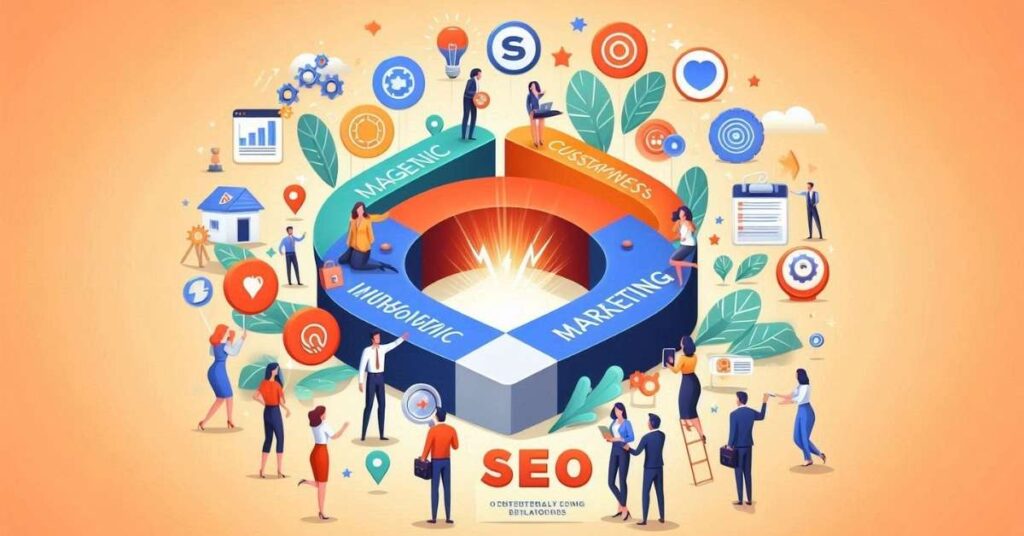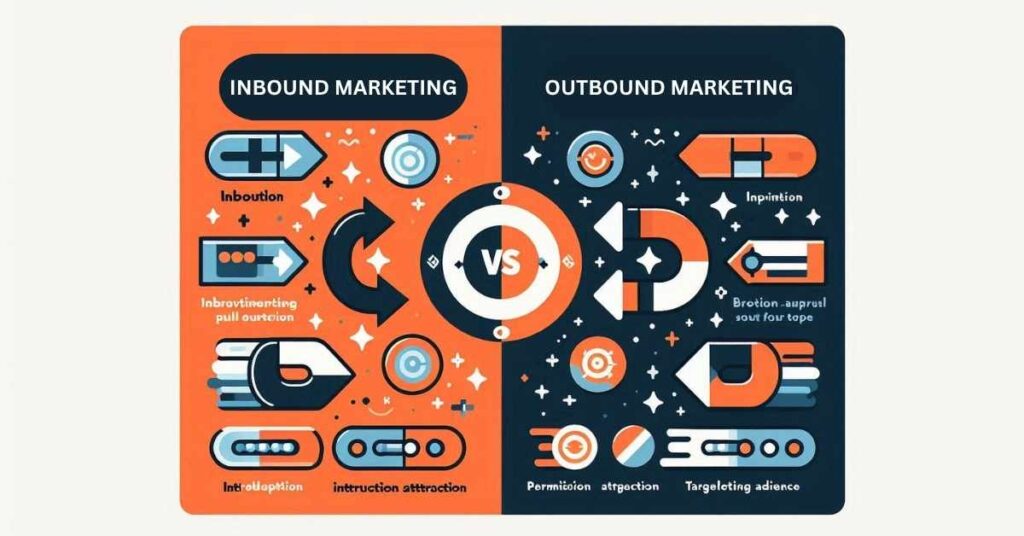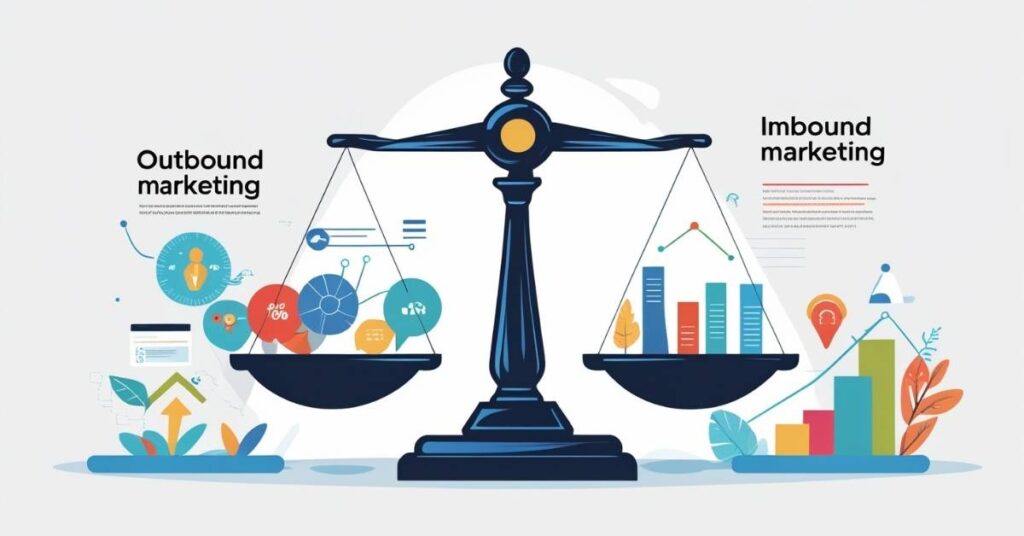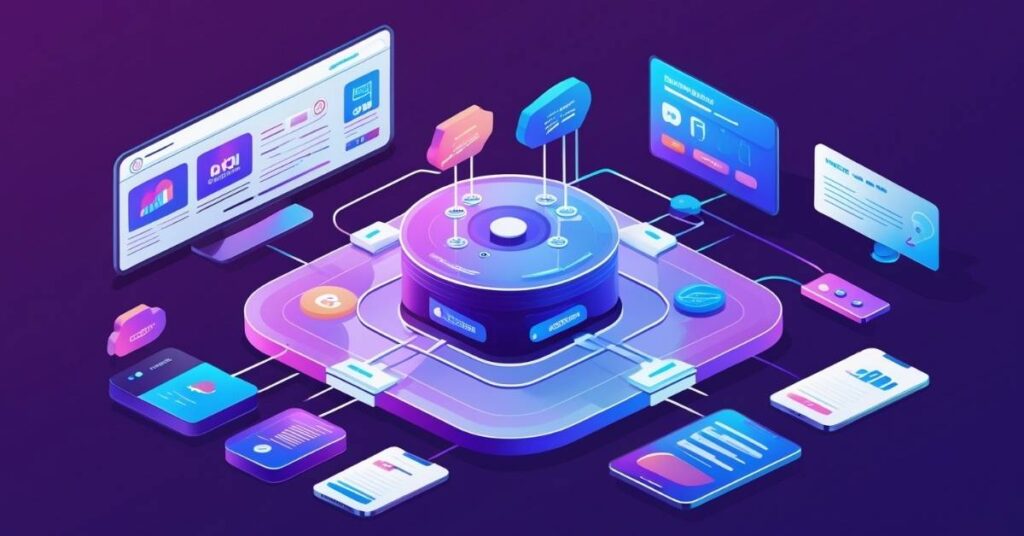Inbound vs. Outbound Marketing: The Great Debate That’s Reshaping Business Strategy
Imagine this: You’re watching your favorite TV show when suddenly, a loud commercial interrupts your viewing experience. Annoying, right? Now, imagine instead you’re searching for the best smartphone online and stumble upon a helpful blog post that answers all your questions while subtly introducing you to a brand. Which experience feels better?
This fundamental difference captures the essence of one of marketing’s most significant debates: inbound versus outbound marketing. In today’s digitally integrated world, where consumers are bombarded with over 5,000 marketing messages daily, the way businesses approach their audience has become more critical than ever.
More sophisticated, customer-centric approaches are increasingly challenging the traditional “spray and pray” methods. But here’s the thing – it’s not simply a matter of old versus new. Both strategies have their place in the modern marketing ecosystem, and understanding when and how to use each can make or break your business strategy.
What is Outbound Marketing?

Outbound marketing, often dubbed “traditional marketing,” is the granddaddy of promotional strategies. Think of it as the extrovert of the marketing world – it’s loud, direct, and doesn’t wait for an invitation to start a conversation.
At its core, outbound marketing involves sending your message to a broad audience, regardless of whether they’ve expressed interest in your product or service. It’s interruption-based marketing that seeks to capture attention through volume and repetition. The methodology is straightforward: cast a wide net and hope to catch some fish.
Classic examples include television and radio commercials, print advertisements in newspapers and magazines, billboards, direct mail campaigns, cold calling, and email blasts to purchased lists. More recently, this category has expanded to include display ads, pop-ups, and sponsored content that appear regardless of user intent.
The underlying philosophy of outbound marketing rests on the assumption that if you put your message in front of enough people, a certain percentage will be interested enough to convert. It’s a numbers game that relies heavily on brand awareness and repetitive exposure. Research suggests that consumers need to encounter a brand 5-7 times before they remember it – a principle that outbound marketing leverages extensively.
What is Inbound Marketing?

Enter inbound marketing – the introverted, thoughtful cousin that prefers meaningful conversations over loud proclamations. Coined by HubSpot’s Brian Halligan in 2005, inbound marketing represents a fundamental shift from interruption-based tactics to attraction-based strategies.
Instead of chasing customers, inbound marketing focuses on creating valuable content and experiences that naturally draw potential customers to your business. It’s permission-based marketing that respects the consumer’s journey and provides value at every touchpoint.
The inbound methodology revolves around four key stages: Attract, Convert, Close, and Delight. During the attract phase, businesses create content that addresses their target audience’s pain points and interests. This might include blog posts, social media content, SEO-optimized web pages, and educational resources.
The convert stage involves capturing visitor information through forms, landing pages, and calls-to-action. The close phase nurtures these leads through email marketing, targeted content, and marketing automation until they’re ready to make a purchase. Finally, the delight stage focuses on providing exceptional customer experiences that turn buyers into advocates.
What makes inbound marketing particularly powerful is its alignment with modern consumer behavior. Today’s buyers are more informed and independent than ever before. Studies show that 70% of the buyer’s journey is completed before a customer contacts a sales representative. Inbound marketing acknowledges this reality by providing valuable information throughout the research and consideration phases.
Key Differences

The distinctions between inbound and outbound marketing extend far beyond their basic definitions. Let’s explore the fundamental differences that set these approaches apart.
Communication Direction: Outbound marketing is unidirectional – it broadcasts messages from the company to the consumer. Inbound marketing, conversely, is bidirectional, encouraging dialogue and engagement between brand and audience.
Audience Targeting: Outbound marketing typically employs a broad-brush approach, targeting large, often undefined audiences with the hope that some will be interested. Inbound marketing uses precise targeting based on buyer personas, demographics, behavior, and expressed interests.
Cost Structure: Outbound marketing often requires significant upfront investments with costs that scale linearly – more reach equals more money. Inbound marketing typically has lower startup costs but requires sustained effort and time to build momentum.
Measurability: Traditional outbound efforts can be challenging to measure accurately. How do you track the ROI of a billboard or radio ad? Inbound marketing, being predominantly digital, offers granular analytics and clear attribution models.
Customer Relationship: Outbound marketing tends to focus on transactions – getting the immediate sale. Inbound marketing prioritizes building long-term relationships through trust and value provision.
Timing: Outbound marketing operates on the company’s timeline, pushing messages when convenient for the business. Inbound marketing works on the customer’s timeline, providing information when and where they need it.
Benefits And Drawbacks

Like any strategy, both approaches come with distinct advantages and limitations that businesses must carefully consider.
Outbound Marketing Advantages: The primary strength of outbound marketing lies in its speed and reach. When you need immediate visibility or have time-sensitive promotions, outbound tactics can deliver quick results. It’s particularly effective for brand awareness campaigns and reaching demographics that might not be actively searching for your solution online. Outbound marketing also offers more control over messaging and timing – you decide when and where your message appears.
Outbound Marketing Disadvantages: The challenges are equally significant. Outbound marketing is increasingly expensive, with costs rising as ad-blocking technology becomes more prevalent and consumers become more skilled at ignoring interruptions. It also suffers from poor targeting; you are often paying to reach people who have no interest in your product. Additionally, measuring ROI can be challenging, and the method is becoming less effective as consumer behavior shifts toward research-driven purchasing decisions.
Inbound Marketing Advantages: Inbound marketing shines in its cost-effectiveness and targeting precision. Content created today can continue attracting customers for years, providing exceptional long-term ROI. It builds trust and authority by providing value before asking for anything in return. The approach also generates higher-quality leads since people who find you through inbound efforts are typically further along in their buying journey. Additionally, inbound marketing provides detailed analytics, making it easier to optimize and improve campaigns.
Inbound Marketing Disadvantages: The primary drawback is time – inbound marketing requires patience and consistent effort before showing significant results. It also demands substantial content creation capabilities and ongoing optimization. For businesses in highly competitive industries, achieving organic visibility can be challenging and expensive. Finally, inbound marketing may struggle to reach audiences who aren’t actively searching for solutions online.
Real-World Examples
To better understand these concepts in action, let’s examine how successful companies have leveraged both approaches.

Outbound Success Story: Dollar Shave Club’s viral video campaign exemplifies effective outbound marketing in the digital age. Their humorous, direct-to-consumer video was essentially an outbound tactic – pushing content to a broad audience through paid promotion and social sharing. The campaign cost $4,500 to produce but generated millions of views and thousands of subscriptions within days.
Inbound Success Story: HubSpot itself serves as an excellent inbound marketing case study. By creating valuable, educational content about marketing, sales, and customer service, they’ve attracted millions of visitors to their website. Their blog, free tools, and educational resources have established them as thought leaders while generating thousands of leads monthly. This approach helped them grow from a startup to a billion-dollar company.
Hybrid Approach Example: Netflix masterfully combines both strategies. They use outbound tactics like billboard advertising and TV commercials to build broad awareness, while simultaneously creating engaging content marketing (like behind-the-scenes content and social media engagement) to deepen relationships with existing subscribers and attract new ones organically.
The Future Perspective

The marketing landscape continues evolving, and the future likely belongs to businesses that can skillfully blend both inbound and outbound strategies. This hybrid approach, often called “integrated marketing,” recognizes that different situations call for different tactics.
Emerging technologies are blurring the lines between inbound and outbound marketing. Programmatic advertising uses inbound principles (targeting based on behavior and interests) within traditionally outbound channels (display ads). Social media advertising allows for highly targeted outbound messaging that feels more like inbound content.
The main thing is to understand your audience’s preferences and meet them where they are. Younger demographics respond better to social media content and influencer partnerships (inbound approaches), while older demographics may still be effectively reached through direct mail and television advertising (outbound approaches).
Furthermore, the customer journey is becoming increasingly complex, with multiple touchpoints across various channels. Successful businesses are creating omnichannel experiences that guide prospects seamlessly from awareness to conversion, regardless of where the initial interaction occurs.
Key Points
As we synthesize the extensive discussion above, several crucial takeaways emerge for modern marketers:
• Strategy Selection Matters: Choose inbound for long-term relationship building and cost-effective lead generation; opt for outbound when you need immediate reach and brand awareness.
• Quality Over Quantity: Inbound marketing’s targeted approach typically generates higher-quality leads, while outbound marketing excels at creating broad awareness quickly.
• Resource Requirements Differ: Inbound demands time, patience, and content creation capabilities; outbound requires larger upfront investments but can show immediate results.
• Measurement Capabilities Vary: Inbound marketing offers superior analytics and ROI tracking, while outbound marketing can be challenging to measure accurately.
• Integration is Key: The most successful businesses don’t choose sides – they integrate both approaches strategically based on their goals, audience, and resources.
• Customer-Centricity Wins: Regardless of the approach, putting customer needs and preferences first will always yield better results than self-serving promotional tactics.
Conclusion

The debate between inbound and outbound marketing isn’t really about choosing winners and losers, it’s about understanding tools and knowing when to use them. Like a skilled carpenter who wouldn’t use only a hammer for every job, successful marketers recognize that different situations require different approaches.
Outbound marketing isn’t dead, despite what some inbound evangelists might claim. It’s evolving, becoming more targeted and sophisticated. Similarly, inbound marketing isn’t a magic bullet that works for every business or situation. The most effective marketing strategies thoughtfully combine elements of both approaches, creating comprehensive programs that attract, engage, and convert customers throughout their journey.
The real question isn’t whether you should use inbound or outbound marketing, it’s how you can best serve your customers while achieving your business objectives. Sometimes that means interrupting them with a well-timed, relevant message. Other times, it means patiently providing value until they’re ready to engage. The art of modern marketing lies in knowing the difference and executing both approaches with skill and authenticity.
As we move forward in an increasingly digital world, one thing remains constant: businesses that prioritize customer value and genuine relationships will outperform those that don’t, regardless of whether their tactics are inbound, outbound, or somewhere in between. The great debate continues, but perhaps that’s exactly as it should be – keeping us all focused on doing better by the people we serve.
Related Articles:
- How to Master Balance Sheet Analysis? Expert Guide with Examples
- Income Statement Formats: Complete 2025 Guide with Examples and Structure
- What Are Current Liabilities And Why They Matter For Financial Success
- Current Assets Essentials: Elevate Your Financial Management Game
- Remote Payroll Jobs: Your Gateway to Flexibility and Financial Growth
- Payroll Advance: Powerful Ways to Enhance Workplace Morale
- Powerful Mobile Marketing Strategies You Must Try
- Best Marketing Tools In An Advertising Plan
- Mastering Revenue Expenditure for Business Success
- Market Research And Its Importance: A Comprehensive Review
- What You Should Know? Notes Payable And Accounts Payable
- Digital Marketing And Strategies: A Comprehensive Review with Examples
- Are Annuities the Best Investment for a Bright Future? A Comprehensive Analysis
- Understanding Capital Expenditure: Definition, Significance, and Its Association in Financial Decision-Making
- Difference Between Accounting And Finance: A Proven Comprehensive Guide For Beginners
- Difference between Annuity due and Ordinary Annuity
- Essential Accounting Software for Small Enterprises
- 5 Best Software For Small Business Accounting





